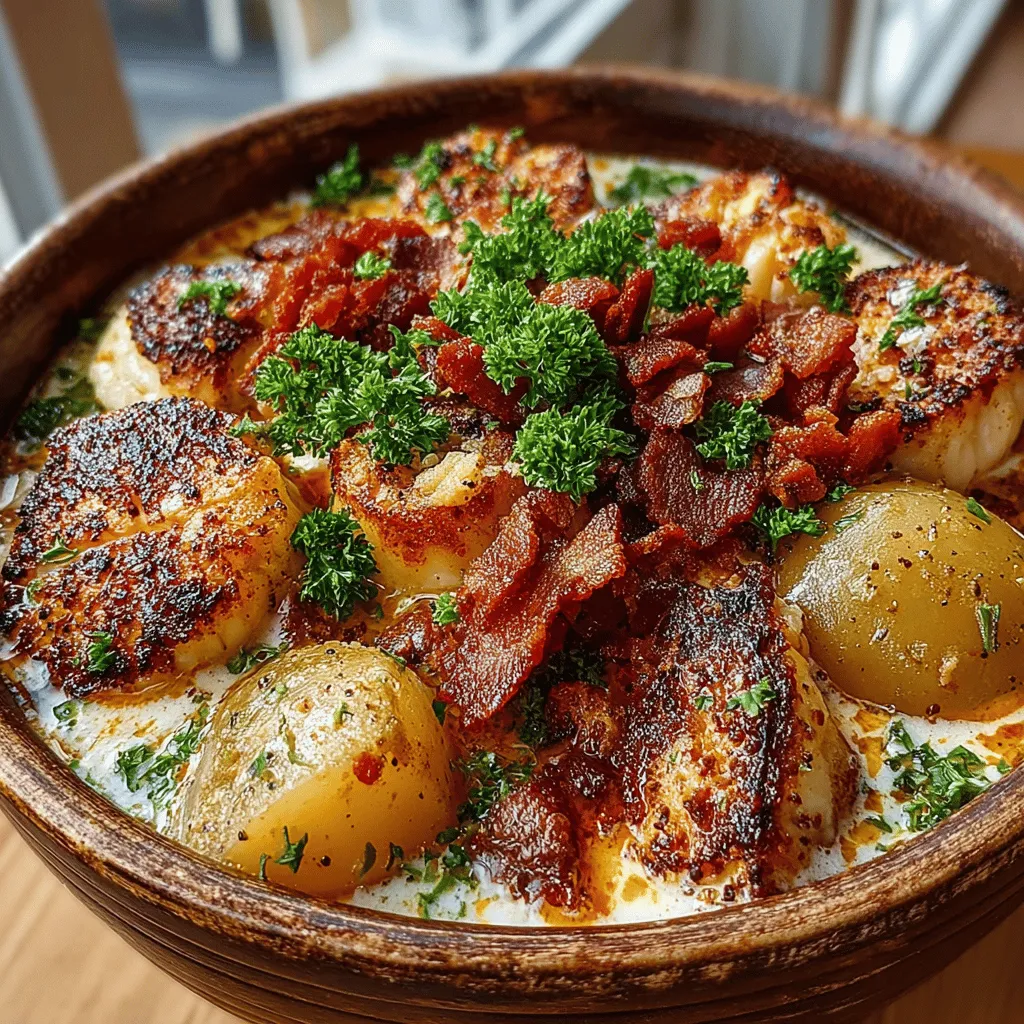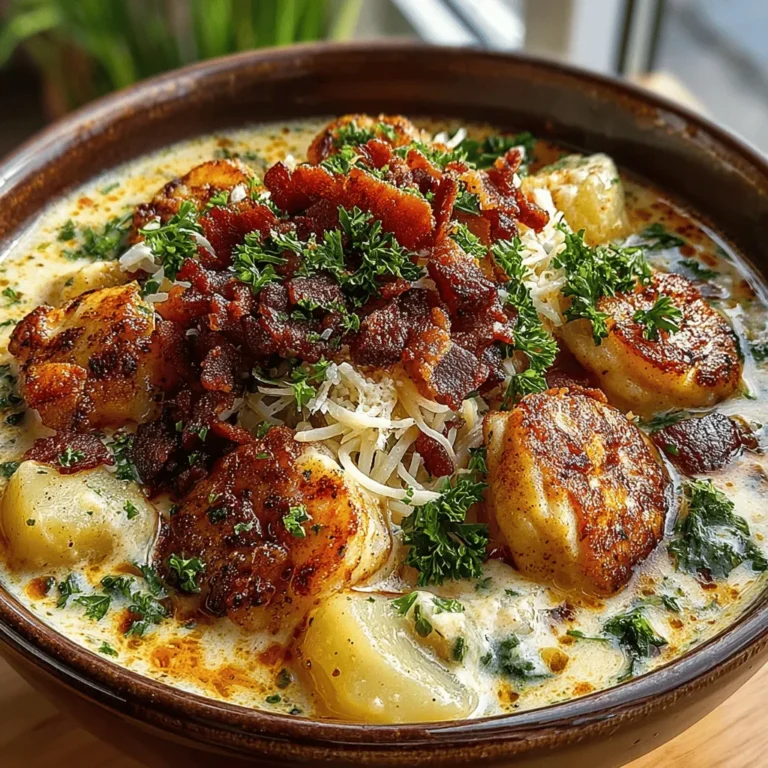Hearty New England Clam Chowder: A Comforting Classic
When it comes to comforting coastal cuisine, few dishes rival the beloved New England clam chowder. This rich and creamy soup encapsulates the essence of New England’s maritime heritage and has become a staple not just in the region, but throughout the United States. With its thick texture, savory flavors, and the briny taste of clams, clam chowder is more than just a meal; it’s a warm embrace in a bowl, perfect for family gatherings and chilly evenings. As we delve into this delightful dish, you’ll discover both its cultural significance and the steps to create your own hearty version at home.
Understanding Clam Chowder
Clam chowder is a type of chowder, which is a thick soup typically made with milk or cream. It has roots dating back to the early 18th century, originating from the coastal communities of New England. The dish was influenced by the region’s abundant seafood and the culinary practices of early settlers, who often combined locally sourced ingredients to create hearty meals. While there are several variations of clam chowder, the two most famous are New England and Manhattan styles.
New England clam chowder is characterized by its creamy base, with a thick, luscious texture that comes from the combination of milk, cream, and potatoes. In contrast, Manhattan clam chowder features a tomato base, giving it a distinctly different flavor profile. The choice between the two often sparks lively debates among chowder enthusiasts, but there’s no denying that both have their loyal fans.
The key ingredients that set New England clam chowder apart include fresh clams, heavy cream, and often, a touch of bacon. These elements work in harmony to create a soup that is both indulgent and satisfying. Each ingredient plays a crucial role, contributing to the overall flavor and texture that has made this dish a cherished classic.
Ingredients Breakdown
Creating an authentic New England clam chowder requires a thoughtful selection of ingredients. Here’s a detailed breakdown of what you’ll need:
– Thick-Cut Bacon: The backbone of flavor in this chowder, thick-cut bacon adds a salty, smoky essence that complements the brininess of the clams. As it cooks, the fat renders out, infusing the soup with richness and depth.
– Onion and Celery: These aromatics form the foundational flavor base of the chowder. Onions provide sweetness, while celery adds a slight crunch and an earthy note. Together, they create a fragrant starting point for the soup.
– Potatoes: Essential for the chowder’s heartiness, diced potatoes absorb flavors while also thickening the soup. They offer a comforting texture that enhances the overall experience, making each spoonful satisfying and filling.
– Clam Juice and Seafood Stock: Quality liquids are vital for a flavorful chowder. Clam juice brings the ocean’s essence directly into the dish, while seafood stock adds complexity. Using homemade or high-quality store-bought options will elevate your chowder significantly.
– Heavy Cream and Milk: These dairy components are what give New England clam chowder its signature creamy texture. The heavy cream adds richness, while the milk balances it out, creating a velvety consistency that coats the back of a spoon beautifully.
– Chopped Clams: Fresh or canned clams can be used, depending on availability. Littleneck or cherrystone clams are popular choices for their tender meat and sweet flavor. The clams add a distinct briny note that is essential to the chowder’s character.
– Herbs and Seasonings: Thyme and bay leaves are classic additions that enhance the flavor profile of the chowder. Thyme brings a subtle earthiness, while bay leaves impart a complex, aromatic quality that rounds out the dish.
– Fresh Parsley: Used as a garnish, fresh parsley not only adds a pop of color but also brightens the flavors of the chowder. Its slight bitterness can balance the richness of the cream, making each bite refreshing.
Step-by-Step Instructions
Now that you have a solid understanding of the ingredients, let’s dive into the initial steps to create your hearty New England clam chowder.
1. Prepare Your Ingredients: Start by gathering all your ingredients. Dice the thick-cut bacon, chop the onion, and celery, and peel and dice the potatoes. If you’re using fresh clams, ensure they are cleaned and chopped.
2. Cook the Bacon: In a large, heavy-bottomed pot or Dutch oven, cook the thick-cut bacon over medium heat until it becomes crispy. The rendered fat will provide a flavorful base for the chowder. Once the bacon is cooked, remove it from the pot and set it aside, leaving the drippings in the pot.
3. Sauté the Aromatics: Add the chopped onions and celery to the pot with the bacon drippings. Sauté them until they are softened and fragrant, typically about 5 minutes. This step is crucial as it builds the foundational flavors of your chowder.
4. Add the Potatoes: Next, introduce the diced potatoes to the pot. Stir them with the sautéed onions and celery, allowing them to soak up the flavors for a minute or two.
5. Incorporate the Liquids: Pour in the clam juice and seafood stock, ensuring the potatoes are fully submerged. Bring the mixture to a boil, then reduce the heat and let it simmer. This will allow the potatoes to cook through and start to break down slightly, thickening the chowder.
From here, the process continues with adding the clams, cream, and seasonings, ultimately bringing everything together for a luscious, comforting bowl of clam chowder. Each step builds on the last, culminating in a dish that embodies the spirit of New England’s coastal cuisine. As you follow the recipe, you’ll not only create a delicious meal but also connect with the rich culinary traditions that make clam chowder a cherished favorite.

Cooking the Bacon
To begin your New England clam chowder, the first step is cooking the bacon. This is a crucial step, as rendering the fat from the bacon not only adds depth and richness to the chowder but also infuses it with flavor. Start by heating a large, heavy-bottomed pot or Dutch oven over medium heat. Once hot, add your chopped bacon (about 4 to 6 slices, depending on your preference) and cook until it becomes crispy and the fat has rendered, usually around 5 to 8 minutes.
Be sure to stir occasionally to prevent sticking and ensure even cooking. Once the bacon is done, use a slotted spoon to remove it from the pot and set it aside on a paper towel-lined plate to drain. Keep the rendered bacon fat in the pot, as it will serve as the flavorful base for the chowder.
Sautéing Aromatics
Next, it’s time to sauté your aromatics. Add one medium onion, finely chopped, and one to two stalks of celery, diced, to the pot with the bacon fat. The goal here is to soften these vegetables until they are translucent, which usually takes about 4 to 5 minutes. This technique is important because it builds the foundational flavors of the chowder.
As the onions and celery cook, stir frequently to prevent them from browning. You want them tender but not caramelized. The aroma will be delightful, signaling that your base for the clam chowder is coming together beautifully.
Simmering the Base
Once your aromatics are perfectly sautéed, it’s time to add your potatoes. Cut about 2 to 3 medium-sized russet potatoes into small, even cubes. Add these to the pot, along with 3 cups of clam juice or broth, which will enhance the seafood flavor. Bring the mixture to a gentle boil, then reduce the heat to a simmer.
Cook the potatoes for about 10 to 15 minutes, or until they are fork-tender but still hold their shape. Timing is essential here; you don’t want mushy potatoes, as they should add texture to the chowder. Stir occasionally, ensuring that nothing sticks to the bottom of the pot.
Incorporating Clams and Cream
Now comes the star of the dish: the clams! If you’re using canned clams, drain them and set aside a portion of the liquid. If you’re using fresh clams, ensure they are cleaned and steamed until they open, discarding any that do not open. Add the clams to the pot along with a cup of heavy cream and the reserved clam liquid. This addition transforms the chowder into a creamy, rich dish that is both comforting and satisfying.
Stir gently to combine and allow the chowder to heat through for another 5 minutes. It’s important not to overcook the clams at this stage, as they can become tough and rubbery.
Seasoning and Final Touches
With the chowder nearly complete, it’s time to season it to taste. Start by adding salt and freshly cracked black pepper. Depending on your preference, you might also want to add a pinch of cayenne pepper for a subtle kick or some fresh thyme for added aroma. Remember to taste your chowder as you season, adjusting until the flavors are balanced.
Lastly, don’t forget to remove the bay leaves (if used) before serving. This step is often overlooked but is essential for a pleasant eating experience.
Serving Suggestions
Presentation is key when serving your clam chowder, as it enhances the overall dining experience. Consider using wide, shallow bowls or rustic bread bowls for an inviting look. A sprinkle of chopped fresh parsley or chives on top adds a pop of color and freshness.
When it comes to pairings, crusty bread or oyster crackers are traditional accompaniments that complement the creamy texture of the chowder. A seasonal salad with mixed greens, vinaigrette, and fresh vegetables can brighten the meal and provide a refreshing contrast to the rich chowder.
Nutritional Information
A typical serving of New England clam chowder (approximately 1 cup) contains about 250-300 calories. The nutritional breakdown often includes around 12 grams of protein, 15 grams of fat, and 20-25 grams of carbohydrates.
For those with dietary considerations, this chowder can be adjusted to accommodate various needs. For a lighter version, consider using reduced-fat milk instead of heavy cream, or for a gluten-free option, ensure that your clam juice and seasonings are certified gluten-free. Additionally, those looking to increase vegetable content can easily add carrots or corn for added nutrition and sweetness.
Cultural Significance and Variations
New England clam chowder is not just a dish; it represents a rich cultural heritage in the Northeastern United States. Originating in the early 18th century, this chowder reflects the region’s maritime history and the availability of fresh clams. It is often associated with coastal towns and has become a staple in many seafood restaurants, especially in Massachusetts.
While New England clam chowder is the most well-known version, there are several regional variations across the United States. For instance, Manhattan clam chowder uses tomatoes, giving it a distinct red color and a different flavor profile entirely. In contrast, Rhode Island clam chowder is broth-based and does not include cream, making it a lighter alternative. Each variation tells a unique story about the local ingredients and culinary traditions of its region.
Conclusion
In summary, making homemade New England clam chowder is a rewarding experience that brings a piece of New England’s coastal charm right into your kitchen. The combination of crispy bacon, tender potatoes, and fresh clams creates a comforting and hearty dish that is perfect for chilly evenings or gatherings with friends and family.
The cultural significance of clam chowder, along with its rich flavors and textures, makes it a beloved staple in many households. By embracing this recipe, you not only enjoy a delicious bowl of chowder but also participate in a long-standing tradition that celebrates the bounty of the sea. So gather your ingredients, follow these steps, and savor the joy of sharing a homemade clam chowder that is sure to warm both hearts and bellies.


